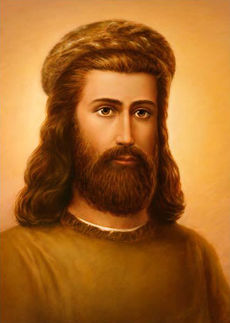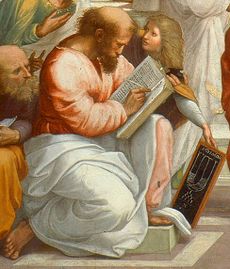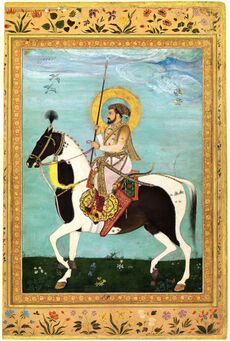Kuthumi/ru: Difference between revisions
PeterDuffy (talk | contribs) (Created page with "Знаменитый Тадж Махал — «чудо из чудес, последнее чудо мира» — был построен как гробница люби...") |
PeterDuffy (talk | contribs) (Created page with "В своем последнем воплощении адепт Кутхуми (известный еще как Кут Хуми и К. X.) вел уединенный обр...") |
||
| Line 54: | Line 54: | ||
=== Koot Hoomi Lal Singh === | === Koot Hoomi Lal Singh === | ||
В своем последнем воплощении адепт Кутхуми (известный еще как Кут Хуми и К. X.) вел уединенный образ жизни; остались лишь краткие свидетельства о его словах и делах. Родившийся в девятнадцатом столетии Махатма Кутхуми был уроженцем Пенджаба, его семья обосновалась в Кашмире. Он посещал Оксфордский Университет в 1850 году и, как полагают, написал статью «Мечта Раваны» для журнала «Дублин Юниверсити» приблизительно в 1854 году, до возвращения на родину. | |||
The Kashmiri Brahman spent considerable time in Dresden, Würzburg, Nürnberg and at the university of Leipzig, where in 1875 he visited with Dr. Gustav Fechner, the founder of modern psychology. His remaining years were spent in seclusion at his lamasery in Shigatse, Tibet, where his contact with the outside world included didactic writings sent by mail to some of his devoted students. These letters are now on file with the British Museum. | The Kashmiri Brahman spent considerable time in Dresden, Würzburg, Nürnberg and at the university of Leipzig, where in 1875 he visited with Dr. Gustav Fechner, the founder of modern psychology. His remaining years were spent in seclusion at his lamasery in Shigatse, Tibet, where his contact with the outside world included didactic writings sent by mail to some of his devoted students. These letters are now on file with the British Museum. | ||
Revision as of 21:49, 30 March 2022

В ознесенный Владыка Кутхуми, прежде занимавший пост Чохана Второго луча мудрости, служит сейчас вместе с Иисусом на посту Мирового Учителя.
Он главой ордена Братьев Золотого Облачения, и обучает искусству медитации и науке Слова учеников, находящихся на Втором луче (луче мудрости), чтобы они смогли стать мастерами-психологами для собственной души.
Воплощения
Тутмосом III
В воплощении Фараоном Тутмосом III (около 1567 года до н. э.), пророком и верховным жрецом, он расширил Египетское царство, присоединив к нему большую часть Ближнего Востока. Наиболее значимая его победа была одержана в битве у горы Кармел. Там он провел всех своих воинов гуськом через узкий проход Мегиддо, внезапно напал на армию, собранную 330 мятежными азиатскими правителями, и разбил ее. Это был дерзкий маневр, против которого выступали все перепуганные военачальники фараона. Один Тутмос был уверен в успехе своего плана и скакал впереди армии, держа над головой образ Амона-Ра — Бога Солнца, обещавшего ему победу.

Пифагор
В шестом столетии до н. э. Кутхуми был греческим философом Пифагором, «светловолосым самосским мудрецом», коего считали сыном Аполлона. Еще юношей Пифагор общался с учеными и жрецами, стремясь найти научное подтверждение внутреннему закону, который был открыт ему во время медитации на Деметру, Мать Земли. Поиски великого синтеза истины привели его в Палестину, затем в Аравию, Индию и, наконец, в храмы Египта, где он завоевал доверие мемфисских жрецов и со временем был допущен к мистериям Изиды в Фивах.
Когда около 529 г. до н. э. азиатский полководец Камбиз вероломно вторгся в Египет, Пифагор был изгнан в Вавилон, где пророк Даниил служил советником царя. Здесь раввины открыли ему сокровенные учения о Я ЕСМЬ ТО ЧТО Я ЕСМЬ, данные Моисею. Волхвы-зороастрийцы обучали его музыке, астрономии и священной науке призывов. По истечении двенадцати лет Пифагор покинул Вавилон и основан братство посвященных в Кротоне — оживленном дорийском портовом городе (ныне это юг Италии). Его «город избранных» был школой мистерий Великого Белого Братства.
В Кротоне тщательно отобранные мужчины и женщины следовали философии, основанной на математическом выражении универсального закона, отображенного в музыке, ритме и гармонии образа жизни, характеризующегося высокой дисциплиной. После пятилетнего испытания строгим молчанием пифагорейские «математики» проходили серию посвящений, развивая интуитивные способности сердца, благодаря которым сын или дочь Бога могли стать, как говорится в «Золотых Стихах» Пифагора, «бессмертным дивным Богом».
Пифагор давал свои наставления, скрытый от взоров учеников, говоря языком символов, полностью понятным лишь самым продвинутым посвященным. Наиболее важной темой его наставлений было основополагающее понимание того, что число является как формой, так и сутью творения. Он сформулировал основные положения евклидовой геометрии и развил астрономические представления, впоследствии приведшие к теории Коперника. Согласно хроникам, две тысячи жителей Кротоны оставили свой привычный образ жизни и собрались в пифагорейской общине под мудрым руководством Совета Трехсот — административного, научного, религиозного ордена, который впоследствии имел большой политический вес в Великой Греции.
Пифагору — «неутомимому адепту» — было девяносто лет, когда Силон, которому было отказано в приеме в школу таинств, организовал жестокое преследование философа. Представ перед судом Кротона, Силон вслух читал тайную книгу Пифагора «Hieros Logos» (Святое Слово), искажая и высмеивая учение. Когда Пифагор и сорок ведущих членов ордена собрались на совет, Силон поджег здание, и все, кто находился там, за исключением двух человек, погибли. В результате этого община распалась, и большая часть учения была утеряна. Тем не менее учитель оказал влияние на многих великих философов, включая Платона, Аристотеля, Августина, Фому Аквинского и Френсиса Бэкона.
Balthazar
► Main article: Three Wise Men
Кутхуми был Валтасаром, одним из трех волхвов, последовавших за звездой Присутствия Младенца-Мессии, он – царь Эфиопии принес Христу — вечному Высшему Жрецу сокровище своего царства – дар ладана.
Франциск Ассизский
► Основная статья: Франциск Ассизский
В воплощении Франциском Ассизским (около 1181-1226) этот божественный нищий, отказавшийся от семьи и богатств и обручившийся с «госпожой Нищетой», жил среди бедняков и прокаженных, обретя несказанную радость в подражании состраданию Христа. В 1209 году, преклонив колени на мессе в день св. Матфея, он услышал, как священник читает евангелие Иисуса и указание Господа своим апостолам идти и проповедовать. Франциск вышел из церкви и начал наставлять в вере и обращать людей. Среди них была и благородная дама по имени Клара, которая вскоре ушла из дома, одевшись, как Христова невеста, и пришла к Франциску, прося позволения вступить в орден нищенствующих.
В одной из многочисленных легенд о жизни Франциска и Клары дается описание их трапезы в Санта Мария дель Анджели, где Франциск с такой любовью говорил о Боге, что все с упоением слушали его. В это время жители деревни заметили, что монастырь и лес горят. Бросившись тушить пожар, они увидели небольшую группу людей с воздетыми к небу руками, окруженных сияющим светом.
Господь открыл Франциску божественное Присутствие в «брате-солнце» и в «сестре-луне» и наградил его за преданность стигматами распятого Христа. Молитва Святого Франциска известна во всем мире, ее читают люди, принадлежащие к любой религии: «Господи, сделай меня орудием Твоего мира!..»


Шах Джахан
В оплотившись Шахом Джаханом (1592-1666), императором Индии из династии Моголов, он низложил продажное правительство своего отца Джахангира и частично восстановил благородную этику своего деда Акбара Великого. Во время его просвещенного правления величие Моголов достигло апогея, и Индия пришла к золотому веку в искусстве и архитектуре. Деньги из имперской казны Шах Джахан тратил на музыку, живопись и строительство величественных монументов, мечетей, общественных зданий по всей Индии, часть которых сохранилась по сей день.
Знаменитый Тадж Махал — «чудо из чудес, последнее чудо мира» — был построен как гробница любимой жены шаха, Мумтаз-Махал. Она правила вместе с ним, почти как равная, и умерла в 1631 году, дав жизнь их четырнадцатому ребенку. Шах Джахан ничего не пожалел, воздвигая памятник, «столь же прекрасный, как и о на». Он является символом Материнского принципа и прославляет вечную любовь императора к Мумтаз
Koot Hoomi Lal Singh
В своем последнем воплощении адепт Кутхуми (известный еще как Кут Хуми и К. X.) вел уединенный образ жизни; остались лишь краткие свидетельства о его словах и делах. Родившийся в девятнадцатом столетии Махатма Кутхуми был уроженцем Пенджаба, его семья обосновалась в Кашмире. Он посещал Оксфордский Университет в 1850 году и, как полагают, написал статью «Мечта Раваны» для журнала «Дублин Юниверсити» приблизительно в 1854 году, до возвращения на родину.
The Kashmiri Brahman spent considerable time in Dresden, Würzburg, Nürnberg and at the university of Leipzig, where in 1875 he visited with Dr. Gustav Fechner, the founder of modern psychology. His remaining years were spent in seclusion at his lamasery in Shigatse, Tibet, where his contact with the outside world included didactic writings sent by mail to some of his devoted students. These letters are now on file with the British Museum.
With El Morya, known as the Master M., Kuthumi founded the Theosophical Society in 1875 through Helena P. Blavatsky, commissioning her to write Isis Unveiled and The Secret Doctrine. The purpose of this activity was to reacquaint mankind with the wisdom of the ages that underlies all of the world’s religions, the inner teachings guarded in the mystery schools since the last days of Lemuria and Atlantis. This includes the doctrine of reincarnation—which, we note, Saint Francis preached in the village squares—as well as an understanding of the ascension as the goal of life sought knowingly or unknowingly by every son and daughter of God.
The Theosophical Society has published Kuthumi’s and El Morya’s letters to their students in The Mahatma Letters and other works. Kuthumi ascended at the end of the nineteenth century.
His mission today
World Teacher
► Main article: World Teacher
In the line of cosmic peerage, Jesus conferred upon the Ascended Master Kuthumi the office of World Teacher, which position our Lord gave to his disciple to share jointly with himself. The World Teachers Jesus and Kuthumi sponsor every soul seeking reunion with God, tutoring them in the fundamental laws governing the cause/effect sequences of their own karma and teaching them how to come to grips with the day-to-day challenges of their individual dharma, one’s duty to fulfill the Christ potential through the sacred labor.
Master psychologist
Kuthumi is known as the master psychologist, and his assignment is to assist chelas in the resolution of their psychology. On January 27, 1985, he announced a dispensation from Lord Maitreya:
This dispensation is my assignment to work with each one of you individually for your physical health and for the healing of your psychology, that we might swiftly get to the very cause and core of physical as well as spiritual and emotional conditions that there be no more setbacks or indulgences and surely not two steps forward and one step back.[1]
Kuthumi has given a key to understanding our psychology in his teachings on the dweller-on-the-threshold and the electronic belt. The momentums of untransmuted karma in orbit around the “nucleus” of the synthetic self (or carnal mind) form what looks like an “electronic belt” of misqualified energy around the lower portion of man’s physical body.
Diagrammed at the point of the solar plexus, extending downward in a negative spiral to below the feet, this conglomerate of human creation forms a dense forcefield resembling the shape of a kettledrum. Referred to as the realm of the subconscious or the unconscious, the electronic belt contains the records of unredeemed karma from all embodiments. At the eye of this vortex of untransmuted energy is the consciousness of the anti-self personified in the dweller-on-the-threshold, which must be slain before one can attain full Christhood.
The master can better help us if we give his mantra, “I AM Light.” This mantra is for the development of a tremendous momentum of white light and the wisdom of God. It is to bring us to the realization that God can and does dwell within us. When we draw nigh to him, he draws nigh to us, and the angelic hosts also gather for the strengthening of the aura. In his book Studies of the Human Aura, Kuthumi speaks of a threefold exercise using the “I AM Light” mantra that students can give for the purpose of strengthening the sheath of the aura so that they can maintain the consciousness of Christ, of God, of Buddha, of Mother.
- I AM Light
- By Kuthumi
- I AM light, glowing light,
- Radiating light, intensified light.
- God consumes my darkness,
- Transmuting it into light.
- This day I AM a focus of the Central Sun.
- Flowing through me is a crystal river,
- A living fountain of light
- That can never be qualified
- By human thought and feeling.
- I AM an outpost of the Divine.
- Such darkness as has used me is swallowed up
- By the mighty river of light which I AM.
- I AM, I AM, I AM light;
- I live, I live, I live in light.
- I AM light’s fullest dimension;
- I AM light’s purest intention.
- I AM light, light, light
- Flooding the world everywhere I move,
- Blessing, strengthening and conveying
- The purpose of the kingdom of heaven.
Kuthumi gives an important key to the spiritual path in his teaching that
... the most important part of any experience you have is not what is flung your way but your reaction to it. Your reaction is the determination of your place on the ladder of attainment. Your reaction enables us to act or not to act. Your reaction to anything or everything shows us the fruit that has ripened in you from all of our prior teaching and loving and support as well as discipline....
Thus, from this hour, if you will call to me and make a determination in your heart to transcend the former self, I will tutor you both through your own heart and any messenger I may send your way. Therefore, heed the voices—not astral but physical—and watch the course of events.... Thus, I come in many guises.[2]
Retreats
Cathedral of Nature
► Основная статья: Собор Природы
Кутхуми является иерархом Храма Озарения в Кашмире, известного так же как Собор Природы.
Kuthumi’s Retreat at Shigatse, Tibet
► Main article: Kuthumi's Retreat at Shigatse, Tibet
From the focus of his etheric retreat at Shigatse, Tibet, Kuthumi plays celestial music on his organ to those who are making the transition called “death” from the physical plane to higher octaves. So tremendous is the cosmic radiation that pours through that organ—because it is keyed to the music of the spheres and an organ-focus in the City Foursquare—that souls are drawn out of the astral plane as if following a pied piper.
In this way, thousands are drawn to the retreats of the masters by the great love of this Brother of the Golden Robe. Those who are able to see Kuthumi at the moment of their passing often find peace in the certain knowing that they have seen the master Jesus, so closely do Jesus and Kuthumi resemble one another in their adoration and manifestation of the Christ.
See also
For more information
Kuthumi and Djwal Kul, The Human Aura: How to Activate and Energize Your Aura and Chakras
Jesus and Kuthumi, Prayer and Meditation
Jesus and Kuthumi, Corona Class Lessons: For Those Who Would Teach Men the Way
Sources
Mark L. Prophet and Elizabeth Clare Prophet, The Masters and Their Retreats, s.v. “Kuthumi.”
Kuthumi and Djwal Kul, The Human Aura: How to Activate and Energize Your Aura and Chakras.
Jesus and Kuthumi, Prayer and Meditation.
